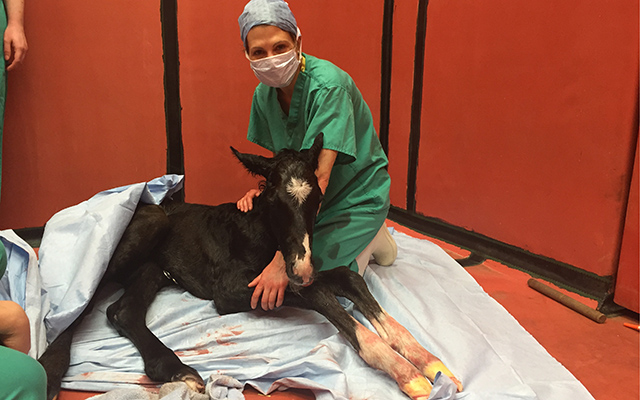When an abnormal presentation cannot be corrected, assisted delivery or caesarean section under general anaesthesia may be required to save mare and foal
With any difficult foaling, time is of the essence.
“The foal is usually delivered within around 20 minutes of the mare’s waters breaking,” says Jennie Henderson MRCVS of Newmarket Equine Hospital (NEH). “Foal survival rates are significantly affected if this is extended.”
When an abnormal presentation cannot be corrected and the foal delivered within 20 minutes, if the mare can be transported to an equine hospital for assisted delivery or caesarean section under general anaesthesia, this offers the best chance of a successful outcome for both mare and foal.
Prolonged and difficult attempts to deliver the foal vaginally can cause severe damage to the mare’s uterus and cervix, which can be life threatening and cause infertility.
Staff at a local thoroughbred stud acted immediately when a foal’s nose did not appear at the birth canal with his feet. Realising that his head was twisted back inside, they took the mare straight to the NEH where she was unloaded into the theatre suite and given a general anaesthetic.
When it proved impossible to correct the flexion of the foal’s head by manipulation, the mare went straight to the operating theatre for an emergency caesarean.
Jennie explains: “An incision was made through the underside of the mare’s abdomen and into her uterus. The foal was lifted out and passed to the resuscitation team, who checked for a heartbeat, clamped the umbilical cord, cleared his nose and rubbed him vigorously with towels to stimulate respiration.
“Fortunately, he started breathing spontaneously and did not need to be intubated or ventilated. A blood test showed that he had experienced a period of low oxygen during the complicated delivery, so oxygen was supplied through a nasal tube. His heartbeat remained regular and increased steadily as he became more active and tried to stand.

“The foal was up within an hour and had a good suckle reflex, which was encouraging. Foals that experience a difficult delivery sometimes suffer problems with brain, gut and kidney function, so he was given medication to try to reduce any damage to these vital organs.”
The foal was fed colostrum by stomach tube while his dam recovered from the anaesthetic. Her maternal instinct kicked in once she was back on her feet and she was soon nursing her new colt.
A very satisfying and successful outcome for all concerned.
